Correcting Misperceptions
about Ethno-Racial Discrimination
The Limits of Evidence-Based Awareness Raising to Promote Support for Equal Treatment Policies
Merlin Schaeffer, Kryzstof Krakowski, und Asmus Olsen
2023-06-04
Discrimination of Muslims in Denmark
Labor market
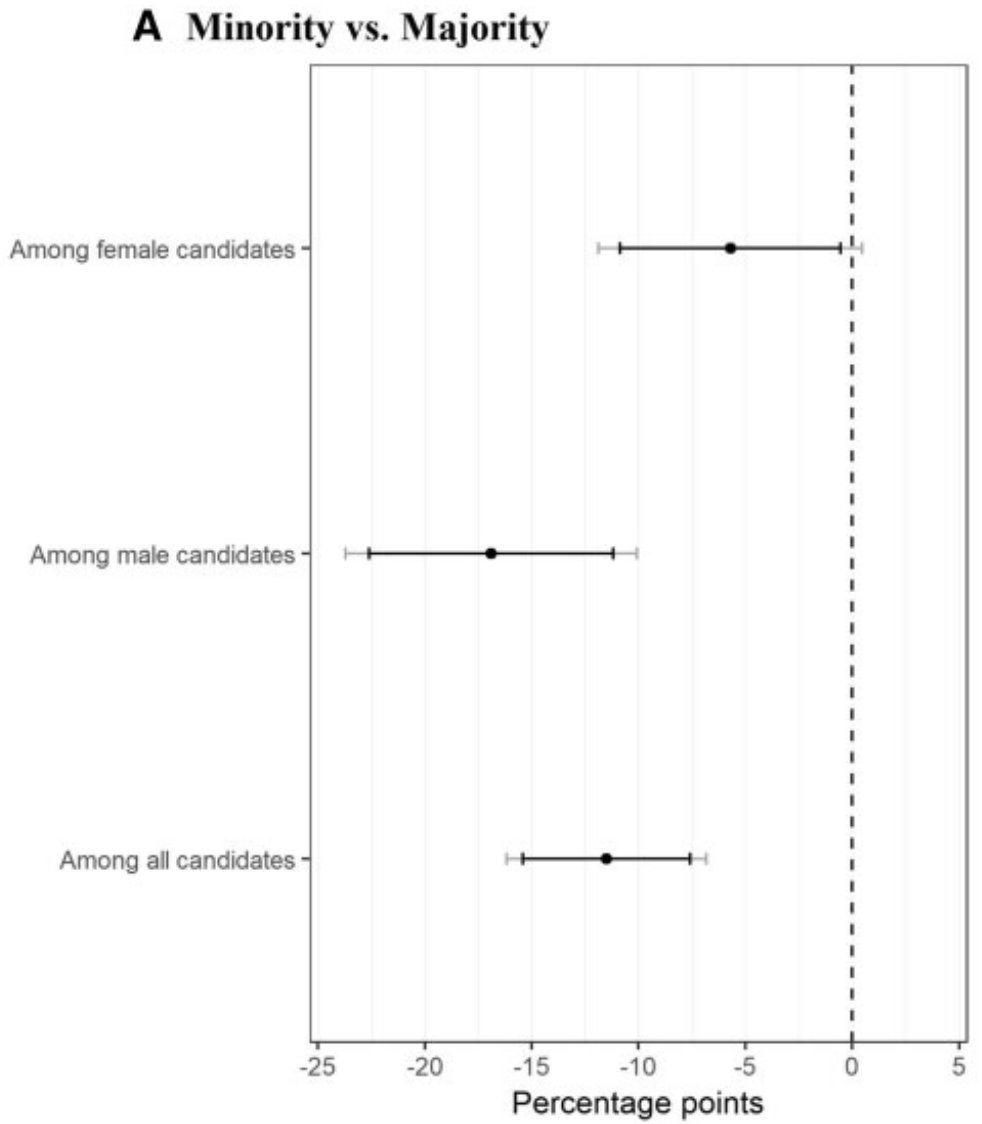 Source: Dahl and Krog (2018)
Source: Dahl and Krog (2018)
Housing market
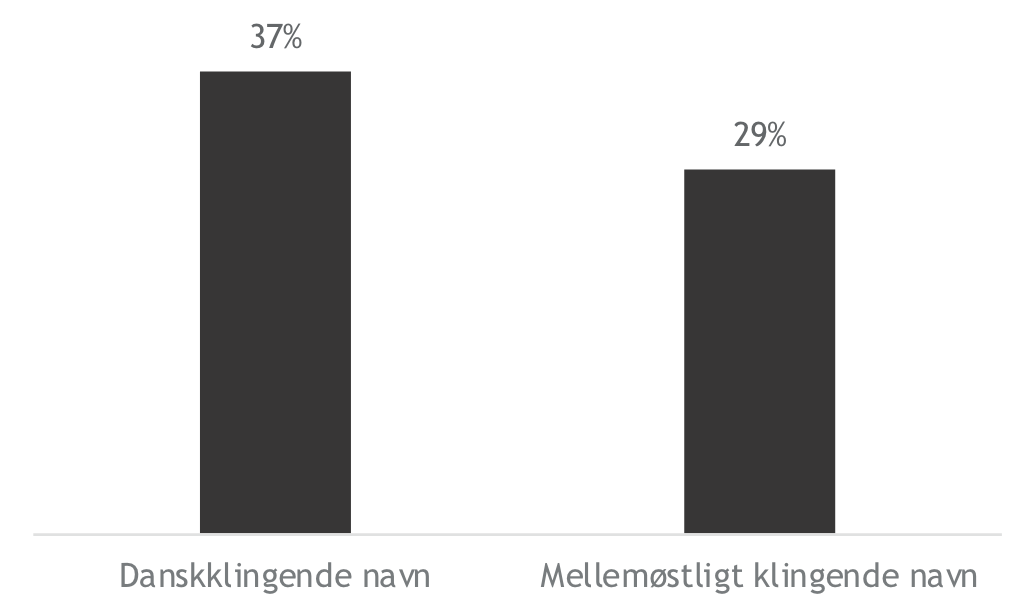 Source: Herby and Haagen Nielsen (2015)
Source: Herby and Haagen Nielsen (2015)
Discrimination of Muslims in Denmark
Primary schools
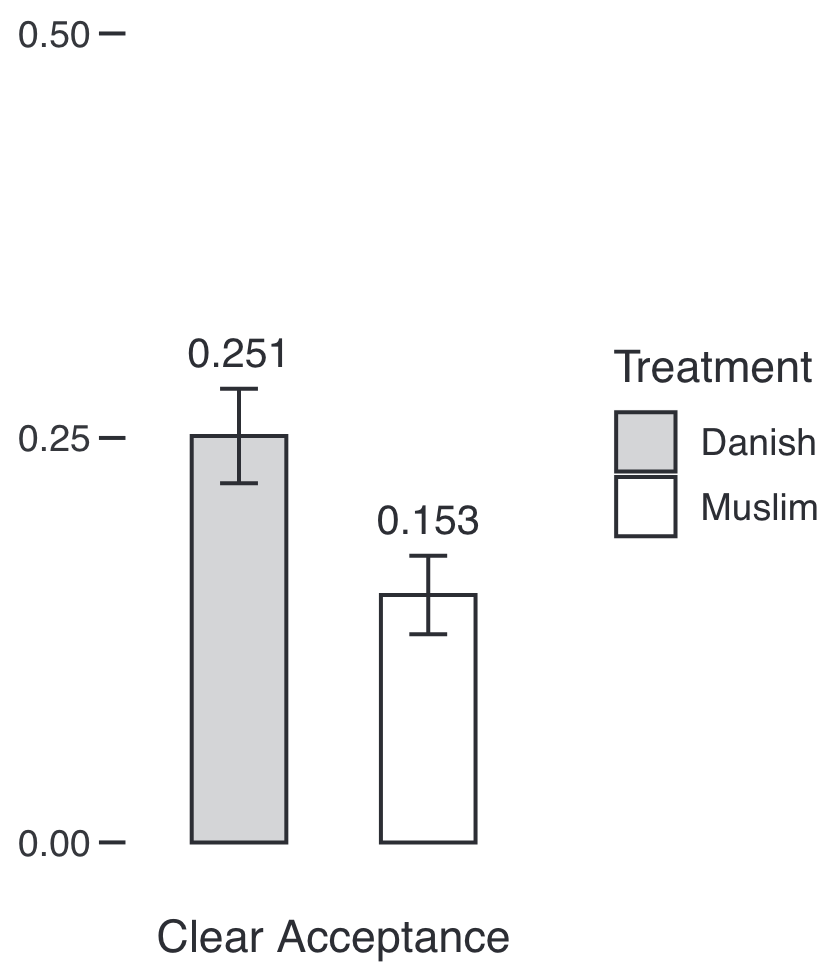 Source: Olsen, Kyhse-Andersen, and Moynihan (2021)
Source: Olsen, Kyhse-Andersen, and Moynihan (2021)
Municipality politicians
 Source: Dinesen, Dahl, and Schiøler (2021)
Source: Dinesen, Dahl, and Schiøler (2021)
One of the primary goals of sociology:
Identify, precisely describe, and consequently raise recognition of social problems.
One of the primary goals of sociology:
Identify, precisely describe, and consequently raise recognition of social problems.
⇒ Do efforts to identify and describe
ethno-racial discrimination
succeed in raising public recognition and support for equal-treatment polices?
Hypothesis 1
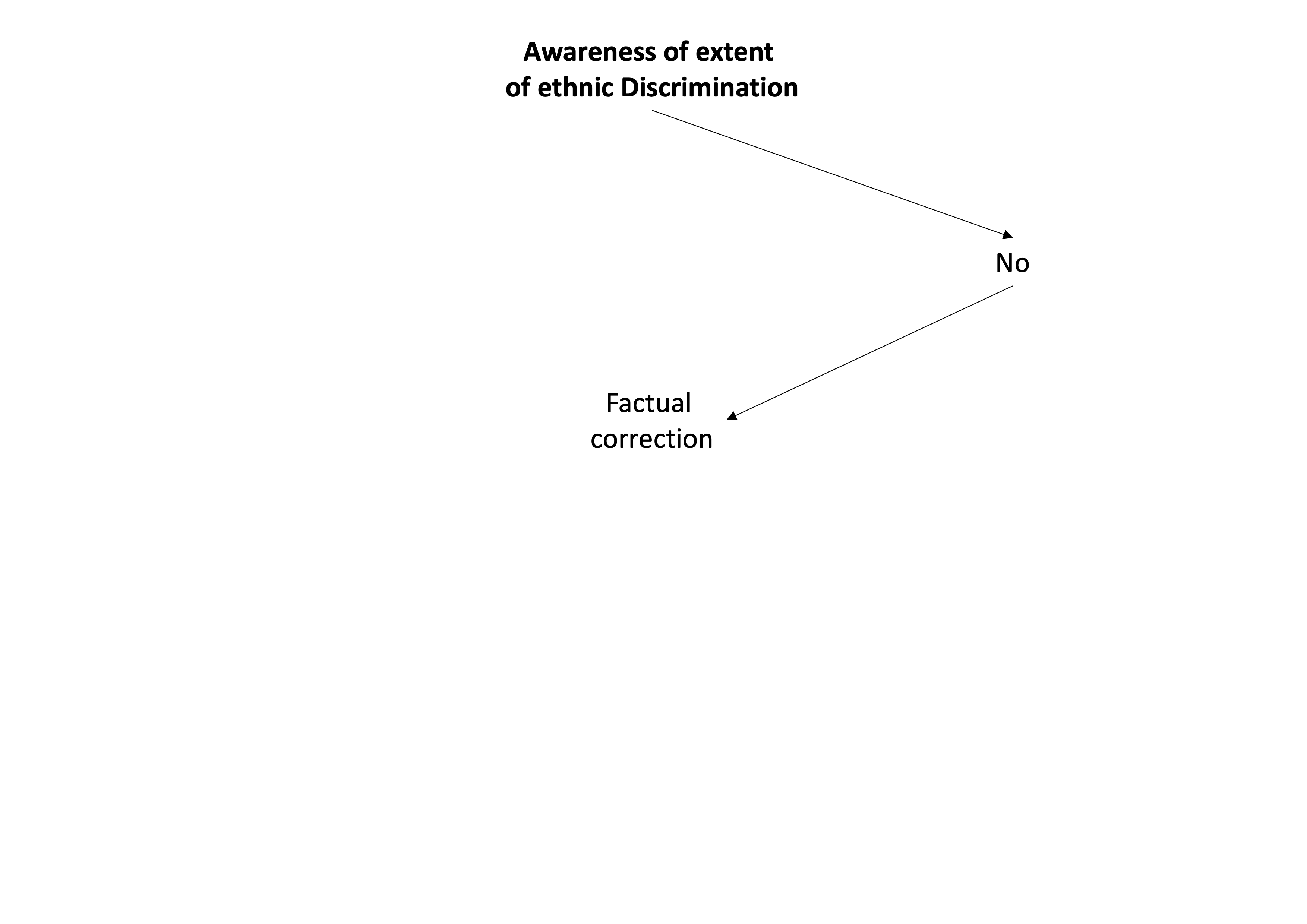
Elicitation of Mis-perceptions of discrimination
- Experimental-design by Haaland and Roth (2022): "Beliefs About Racial Discrimination and Support for Pro-Black Policies" in the US.


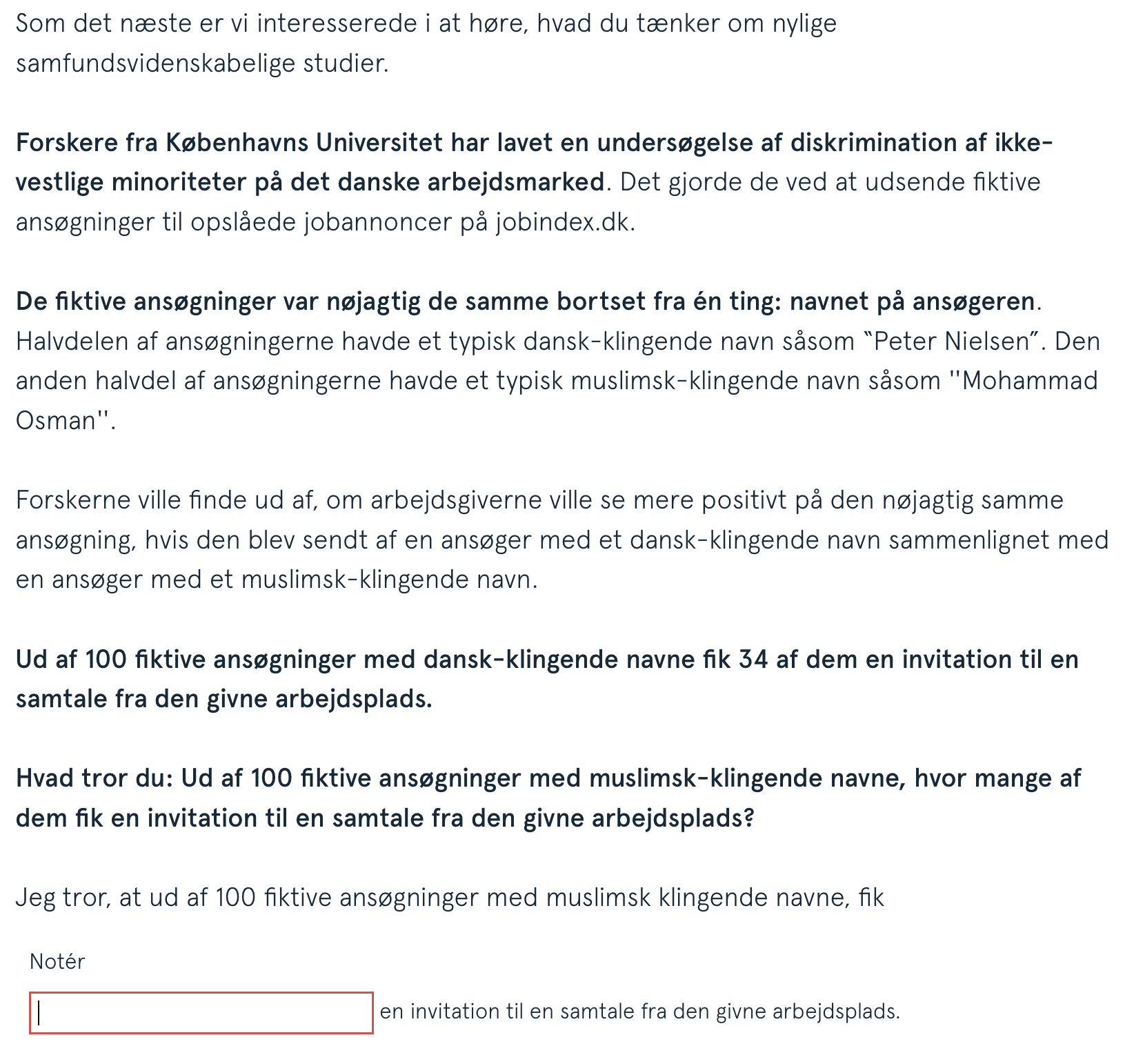
Elicitation of Mis-perceptions of discrimination
Now we are interested in hearing your thoughts on a recent social science study.
Researchers from the University of Copenhagen conducted a study on discrimination against non-Western minorities in Danish primary schools. They did this by sending fictitious applications to primary schools in Denmark, where a parent requested to transfer their child to the school's 3rd grade.
The fictitious applications were exactly the same except for one thing: the name of the father of the child who was to be admitted to the school and who sent the email. Half of the applications had a typically Danish-sounding name such as "Peter Nielsen," while the other half had a typically Muslim-sounding name such as "Mohammad Osman."
The researchers wanted to find out whether schools would view the exact same application more positively if it was sent by a parent with a Danish-sounding name compared to a parent with a Muslim-sounding name.
Out of 100 fictitious applications with Danish-sounding names, 25 of the applications were able to get the child admitted to the school.
What do you think: out of 100 fictitious applications with Muslim-sounding names, how many of the applications were able to get the child admitted to the school?
It's not for a lack of wokeness
Mis-perception of ethnic discrimination by primary schools
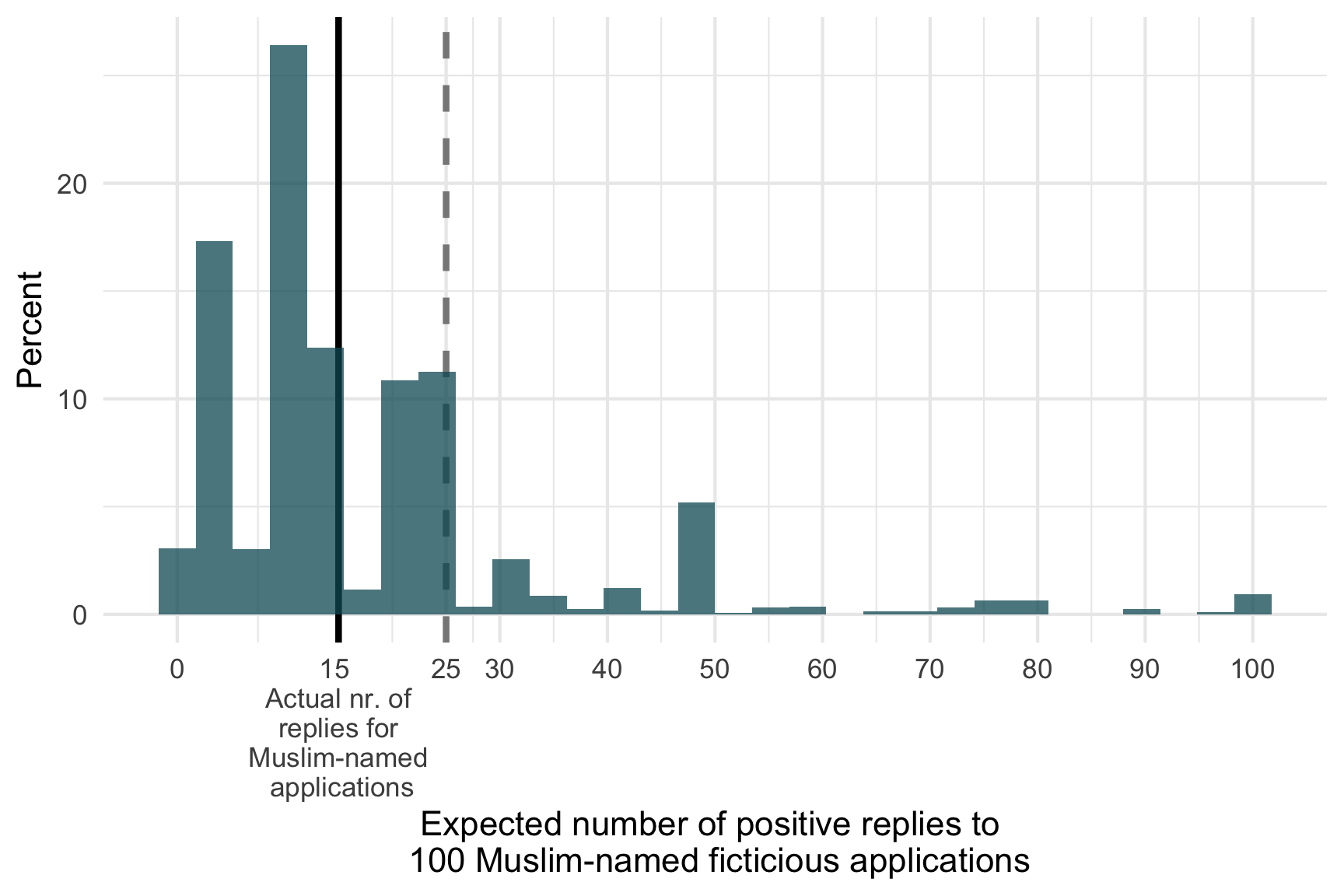
Post-stratification weighted results based on a random sample of 1041 mainstream Danes (born in DK and both parents born in DK).
It's not for a lack of wokeness
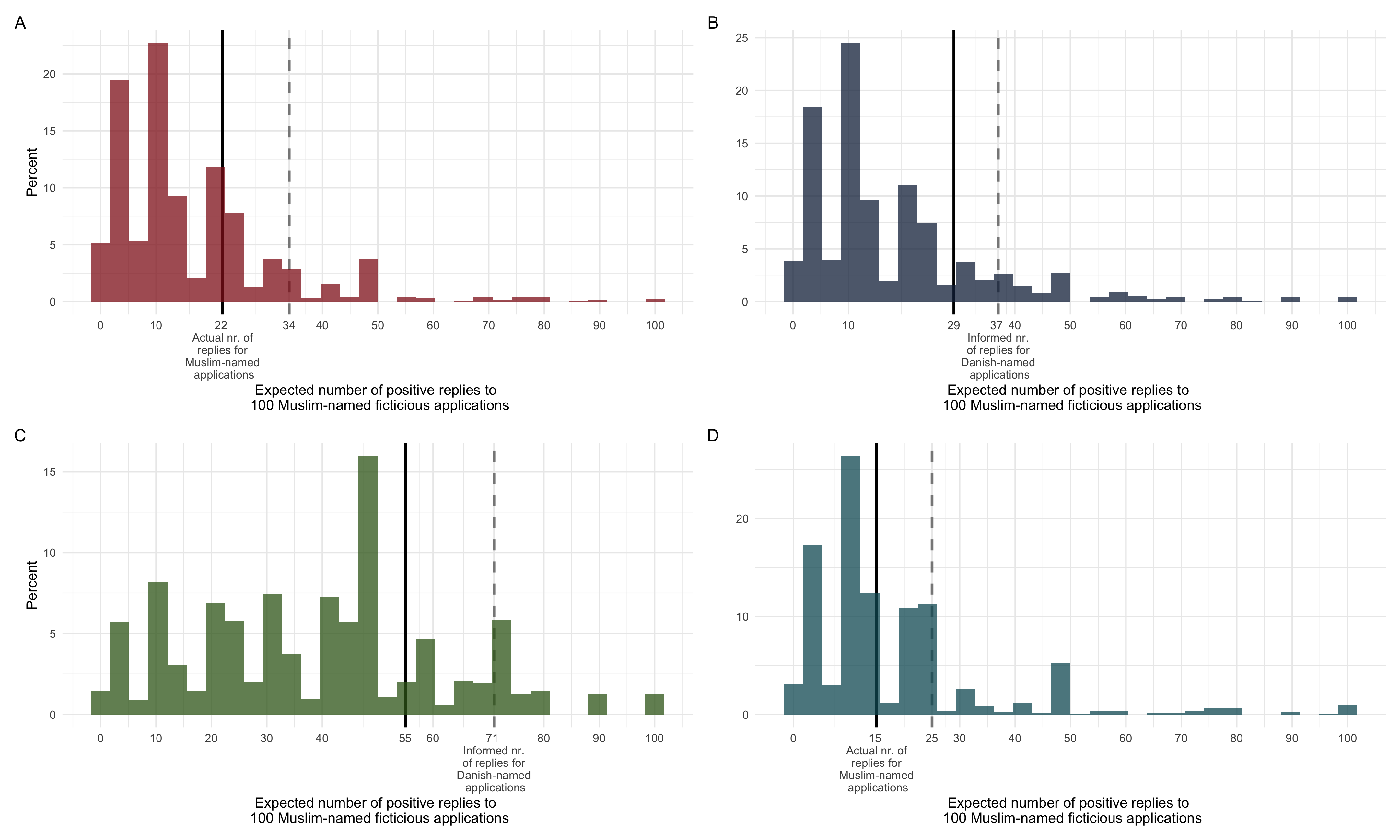
Post-stratification weighted results based on a random sample of each approx. 1041 mainstream Danes (born in DK and both parents born in DK).
Factual correction
- Experimental-design by Haaland and Roth (2022).
→ A random 15 of respondents was corrected.

Factual correction
- Experimental-design by Haaland and Roth (2022).
→ A random 15 of respondents was corrected.
The researchers found that out of 100 fictitious applications with Muslim-sounding names, 15 of the applications were able to get the child admitted to the school. In comparison, 25 out of 100 applications were able to get the child admitted to the school when the application had a Danish-sounding name.
This means that primary schools were 67% more likely to admit a student with a Danish-sounding name compared to a student with a Muslim-sounding name.
Factual correction
- Experimental-design by Haaland and Roth (2022).
→ A random 15 of respondents was corrected.
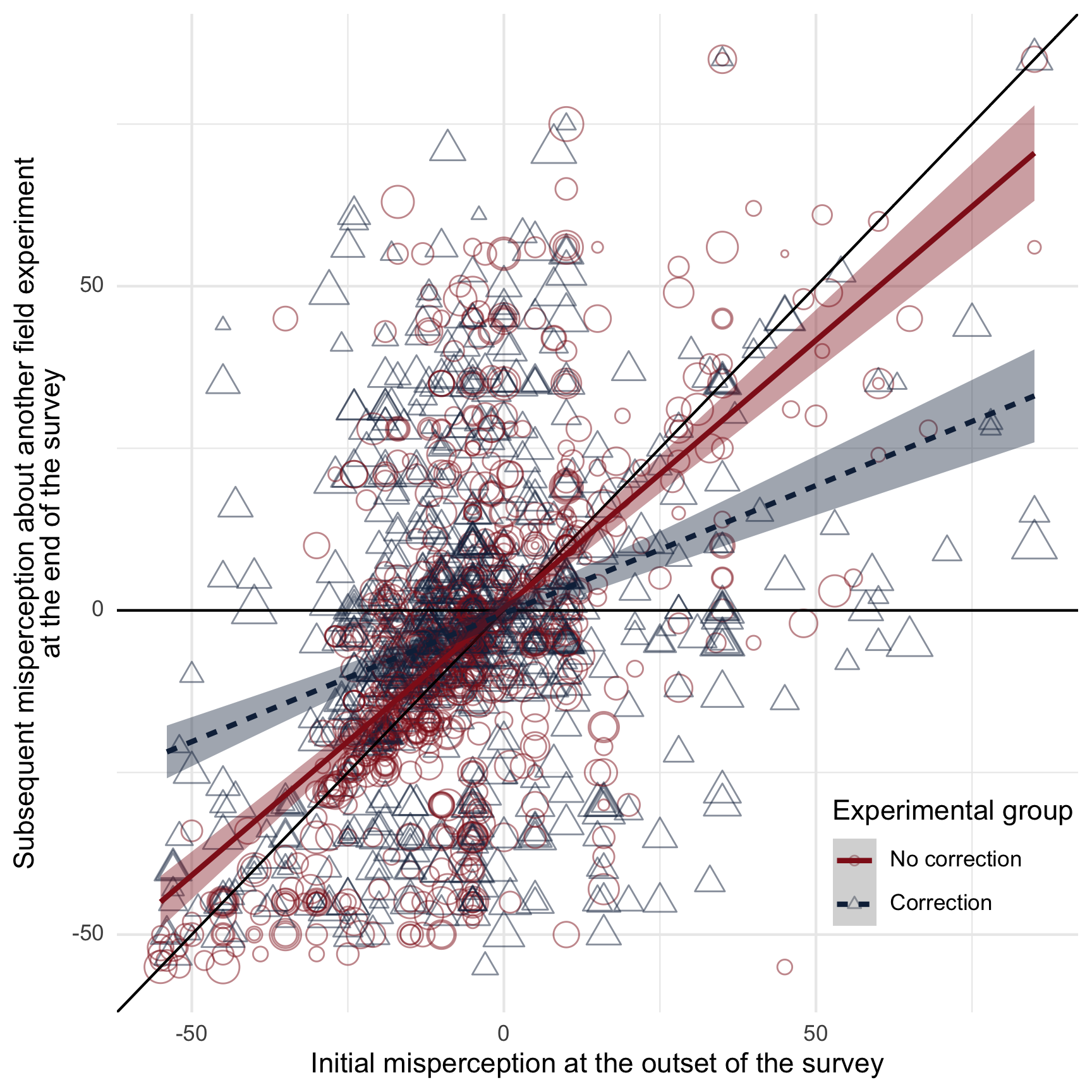
Post-stratification weighted OLS regression with 95% confidence interval. n = 1669.
Factual correction
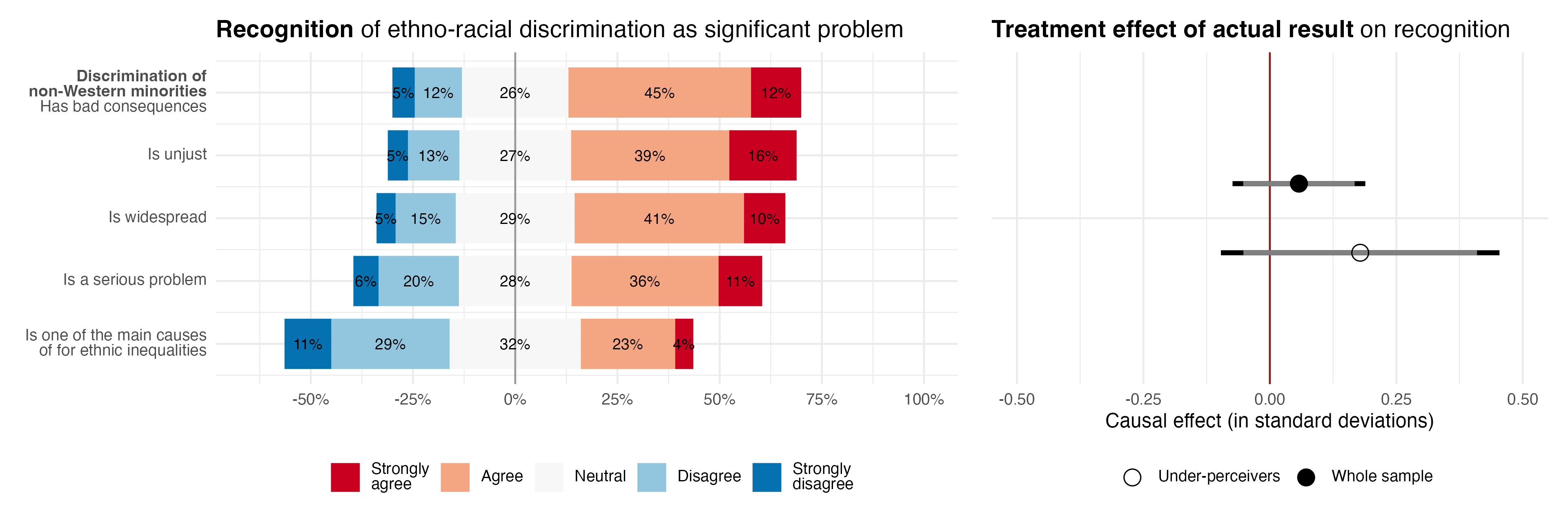
Post-stratification weighted results. On the right: OLS point estimate with robust 90 & 95% confidence intervals. Results are adjusted for the extent of the initial misperception of discrimination, type of field experiment, age, gender, region, education, household size, and labor force status. n = 769.
Factual correction
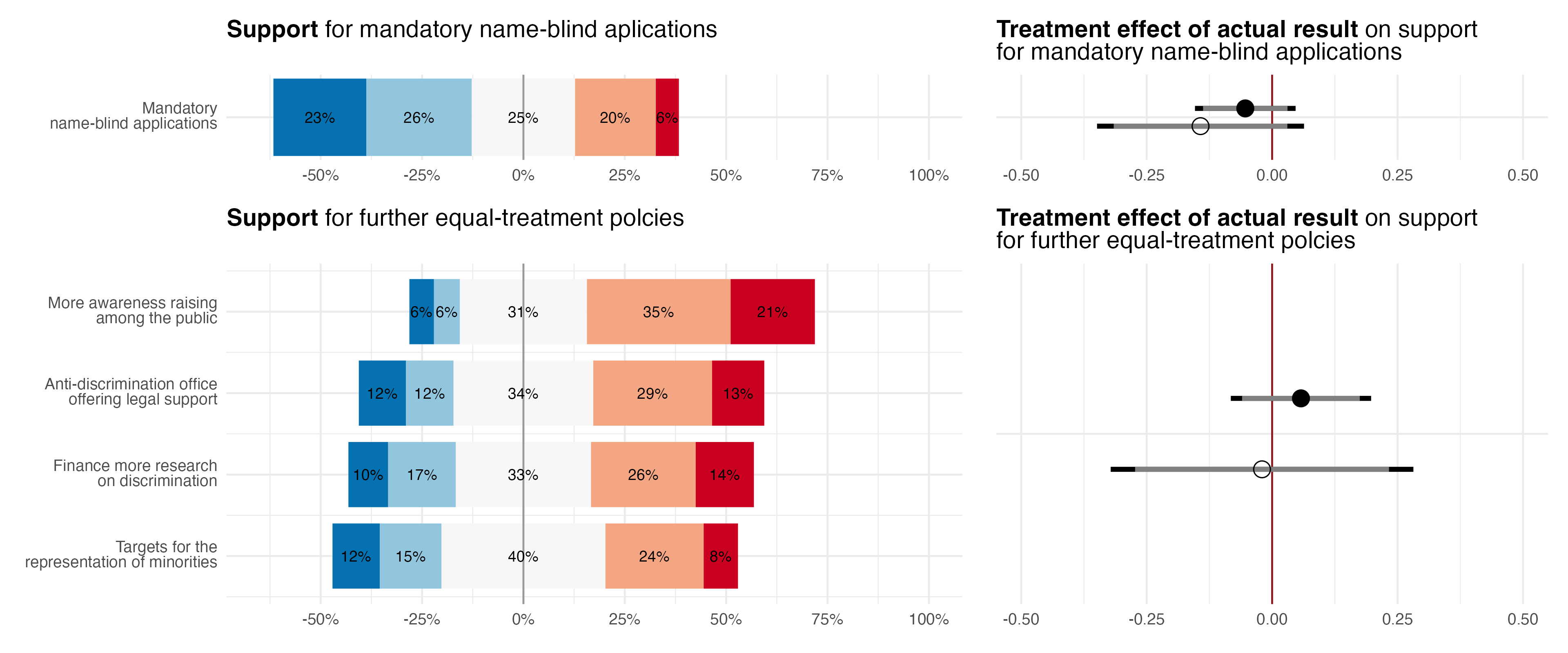
Post-stratification weighted results. On the right: OLS point estimate with robust 90 & 95% confidence intervals. Results are adjusted for the extent of the initial misperception of discrimination, type of field experiment, age, gender, region, education, household size, and labor force status. n = 1562 & 758.
Factual correction

Post-stratification weighted results. On the right: OLS point estimate with robust 90 & 95% confidence intervals. Results are adjusted for the extent of the initial misperception of discrimination, type of field experiment, age, gender, region, education, household size, and labor force status. n = 1,189.
Hypotheses 2, 3 & 4
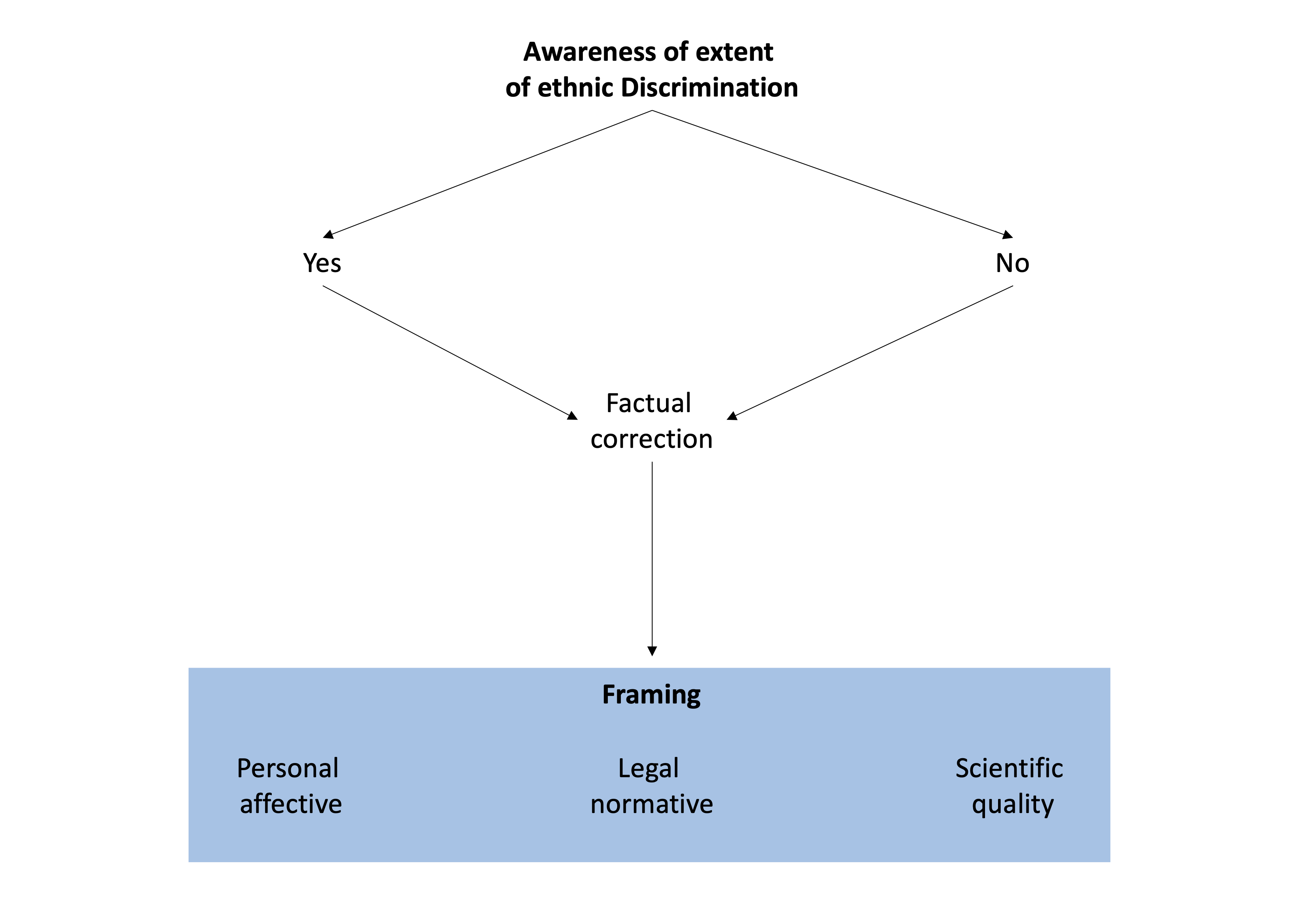
Framing scientific quality
- Advancement of experimental-designs by Haaland and Roth (2022).
→ A random 15 of respondents additionally received the following framing of the correction:
We asked #Name, who is a university researcher, for a comment on the study. S/he explained:
"The results are credible. The study was conducted according to the highest standards of evidence within the research field."
 Kristianna Bakkær Simonsen,
Kristianna Bakkær Simonsen,
Aarhus Universitet
 Martin Vinæs Larsen,
Martin Vinæs Larsen,
Aarhus Universitet
 Jakob Majlund Holm,
Jakob Majlund Holm,
Aarhus Universitet
 Mathilde Cecchini,
Mathilde Cecchini,
Aarhus Universitet
Framing legal and normative
→ A random 15 of respondents additionally received the following framing of the correction:
We asked #Name, who is a lawyer, for a comment on the study. S/he explained:
"The results are alarming. Discrimination like this is prohibited by Danish law."
 Tine Birkelund,
Tine Birkelund,
Institut for Menneske Rettigheder
 Nikolaj Nielsen,
Nikolaj Nielsen,
Institut for Menneske Rettigheder
 Tarek Hussein,
Tarek Hussein,
Institut for Menneske Rettigheder
 Nanna Margrethe Krusaa,
Nanna Margrethe Krusaa,
Institut for Menneske Rettigheder
Framing personal and affective
→ A random 15 of respondents additionally received the following framing of the correction:
We asked #Name, who is a non-Western minority person, for a comment on the study. S/he explained:
"The results make me sad. It worries me to hear that people with a name like mine are not treated equally."
 Loubna Mekhchoun
Loubna Mekhchoun
 Mohammed Al'Bannay
Mohammed Al'Bannay
 Hassan Musse
Hassan Musse
 Yasmin Mohammed
Yasmin Mohammed
Framing
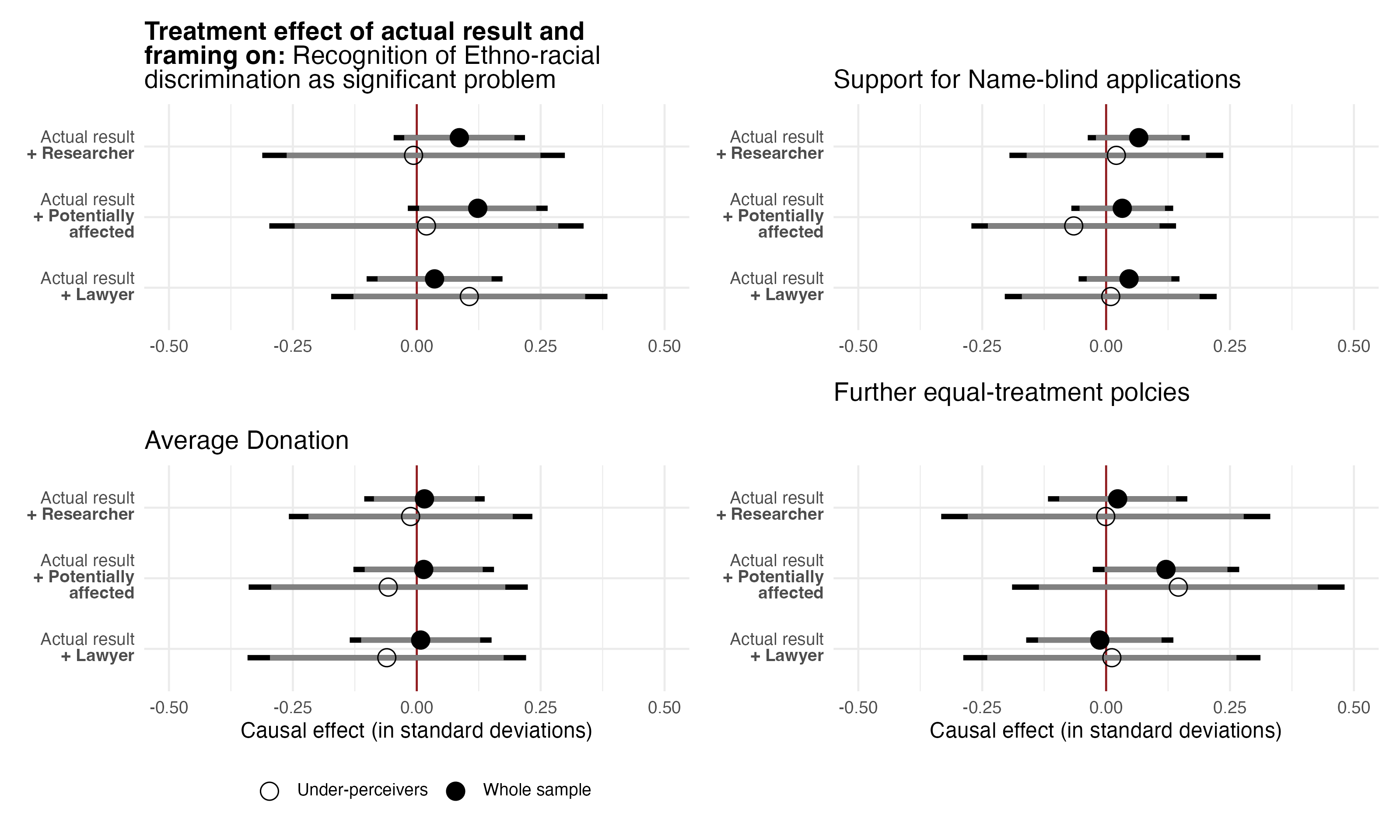
Post-stratification weighted OLS point estimate with robust 90 & 95% confidence intervals. Results are adjusted for the extent of the initial misperception of discrimination, type of field experiment, age, gender, region, education, household size, and labor force status. n = 2,973, 3,904, 1,895 & 2,973.
Hypothesis 5
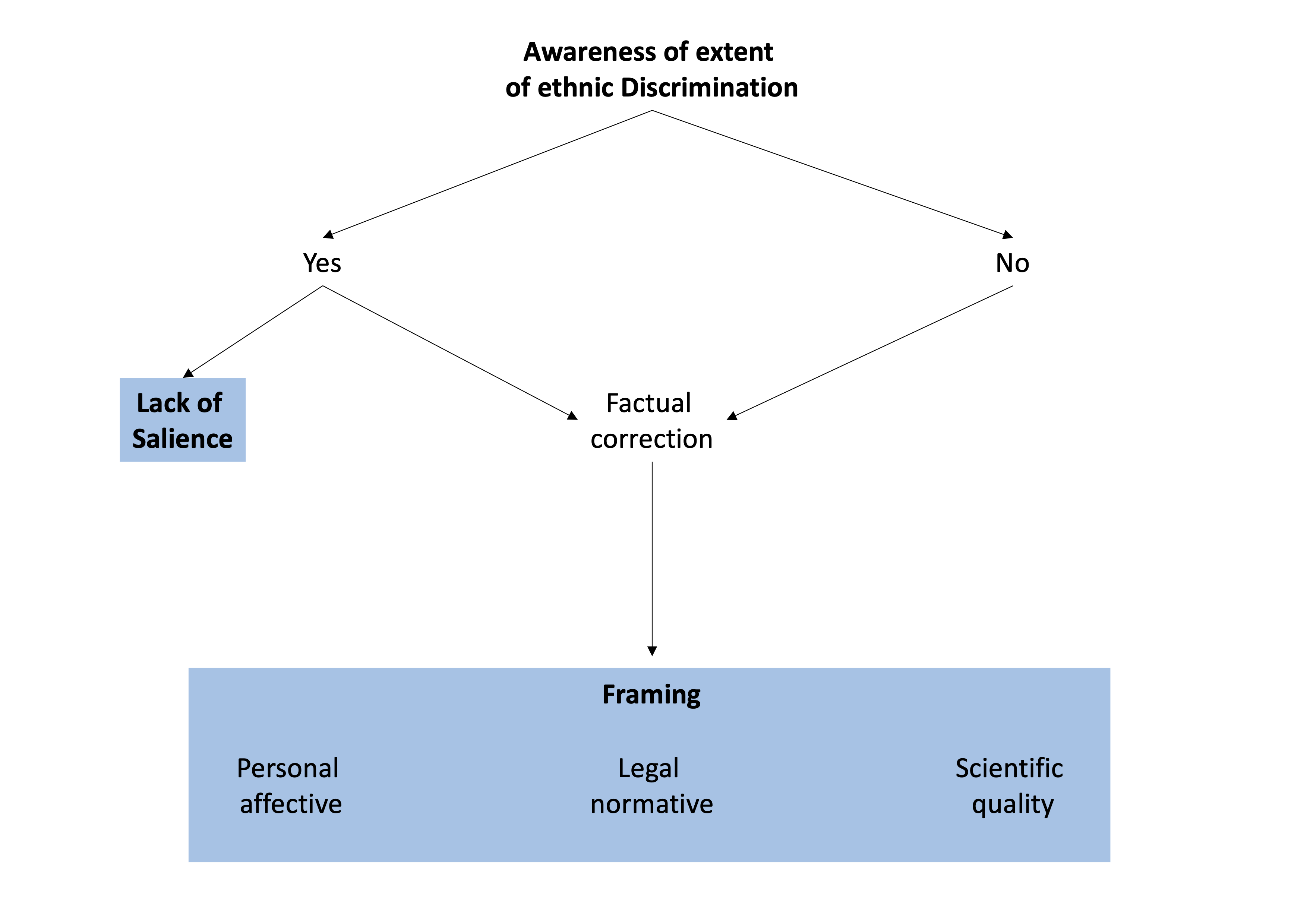
Priming effect?
Researchers from the University of Copenhagen conducted a study on discrimination against non-Western minorities in Danish primary schools. They did this by sending fictitious applications to primary schools in Denmark, where a parent requested to transfer their child to the school's 3rd grade.
...
Priming effect?
Researchers from the University of Copenhagen conducted a study on discrimination against non-Western minorities in Danish primary schools. They did this by sending fictitious applications to primary schools in Denmark, where a parent requested to transfer their child to the school's 3rd grade.
...
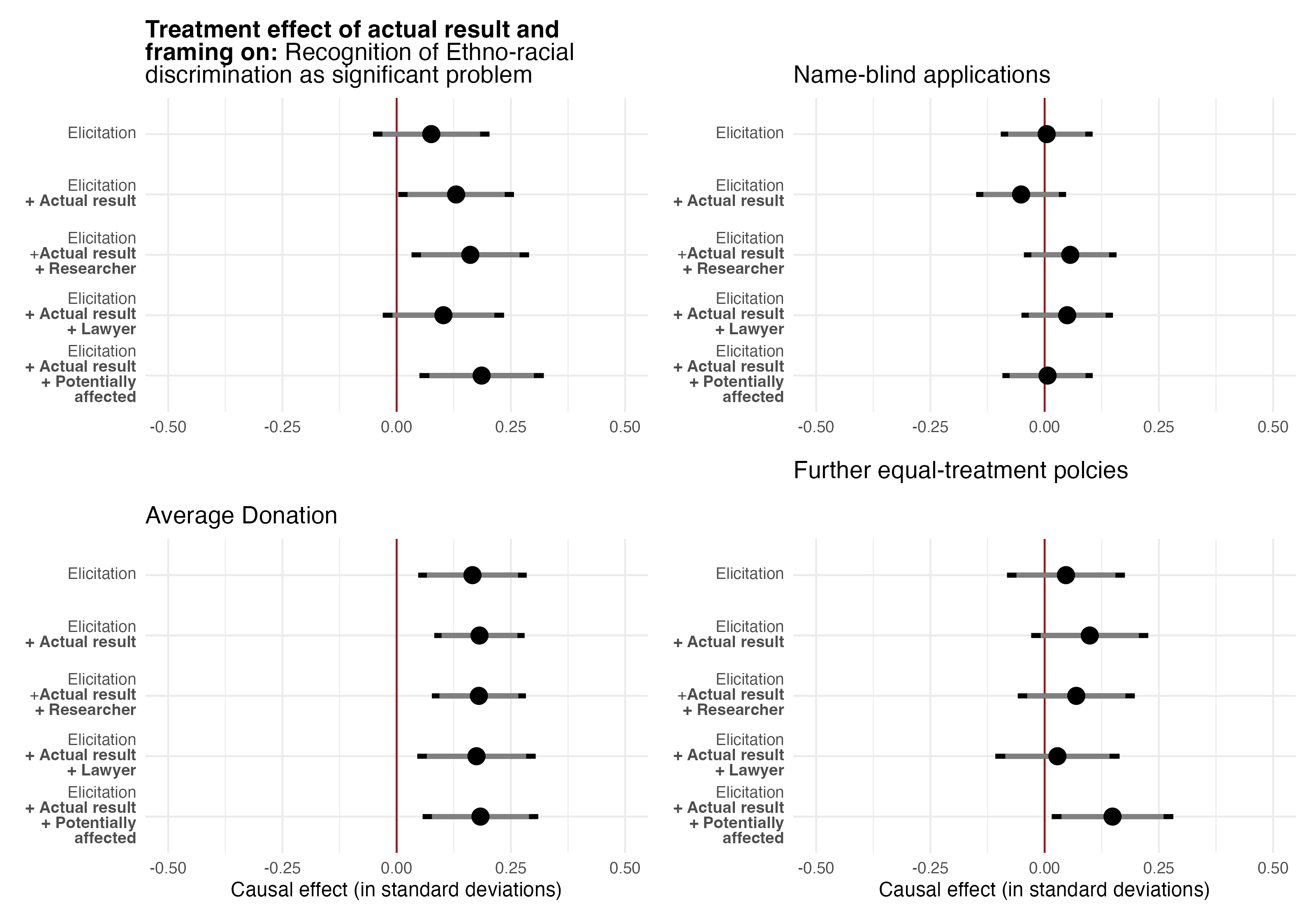
Post-stratification weighted OLS point estimate with robust 90 & 95% confidence intervals. Results are adjusted for the extent of the initial misperception of discrimination, type of field experiment, age, gender, region, education, household size, and labor force status. n = 2,973, 3,904, 1,895 & 2,973.
Conclusion
Evidence-based awareness raising is unlikely to be successful.
While citizens may donate to recognize minority hardships, they hesitate to endorse policies that could impact their group's privileges.
Thank you for
for your Attention!
References
Dahl, M. and N. Krog (2018). "Experimental Evidence of Discrimination in the Labour Market: Intersections between Ethnicity, Gender, and Socio-Economic Status". In: European Sociological Review, pp. 402-417.
Dinesen, P. T., M. Dahl, and M. Schiøler (2021). "When Are Legislators Responsive to Ethnic Minorities? Testing the Role of Electoral Incentives and Candidate Selection for Mitigating Ethnocentric Responsiveness". In: American Political Science Review, pp. 450-466.
Haaland, I. and C. Roth (2022). "Beliefs about Racial Discrimination and Support for Pro-Black Policies". In: The Review of Economics and Statistics, pp. 1-15.
Herby, J. and U. Haagen Nielsen (2015). "Rapport om etnisk diskrimination pa boligmarkedet".
Olsen, A. L., J. H. Kyhse-Andersen, and D. Moynihan (2021). "The Unequal Distribution of Opportunity: A National Audit Study of Bureaucratic Discrimination in Primary School Access". In: American Journal of Political Science.
Quillian, L. and A. H. Midtbøen (2021). "Comparative Perspectives on Racial Discrimination in Hiring: The Rise of Field Experiments". In: Annual Review of Sociology, pp. 391-415.
Appendix
Factual correction
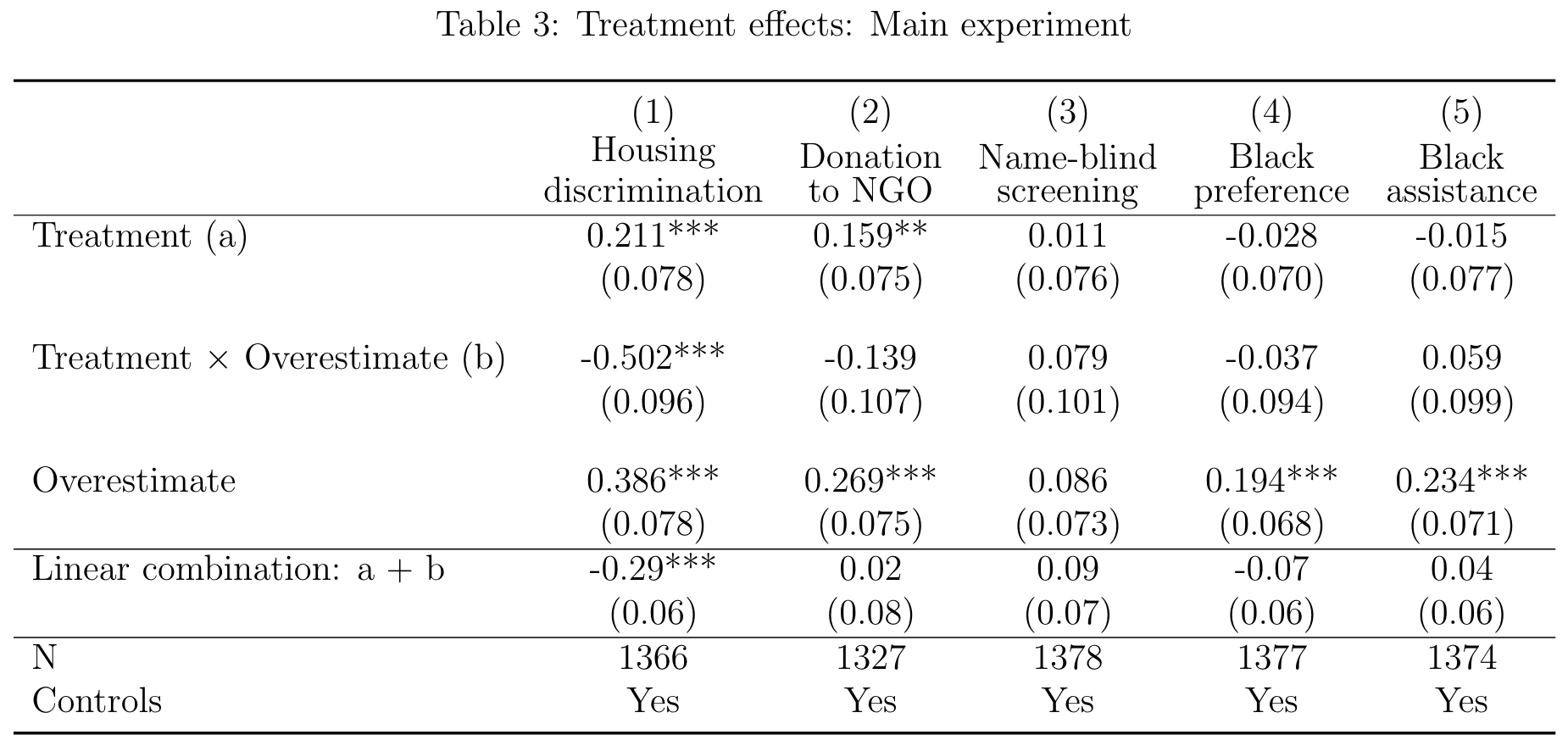 Source: Haaland and Roth (2022)
Source: Haaland and Roth (2022)